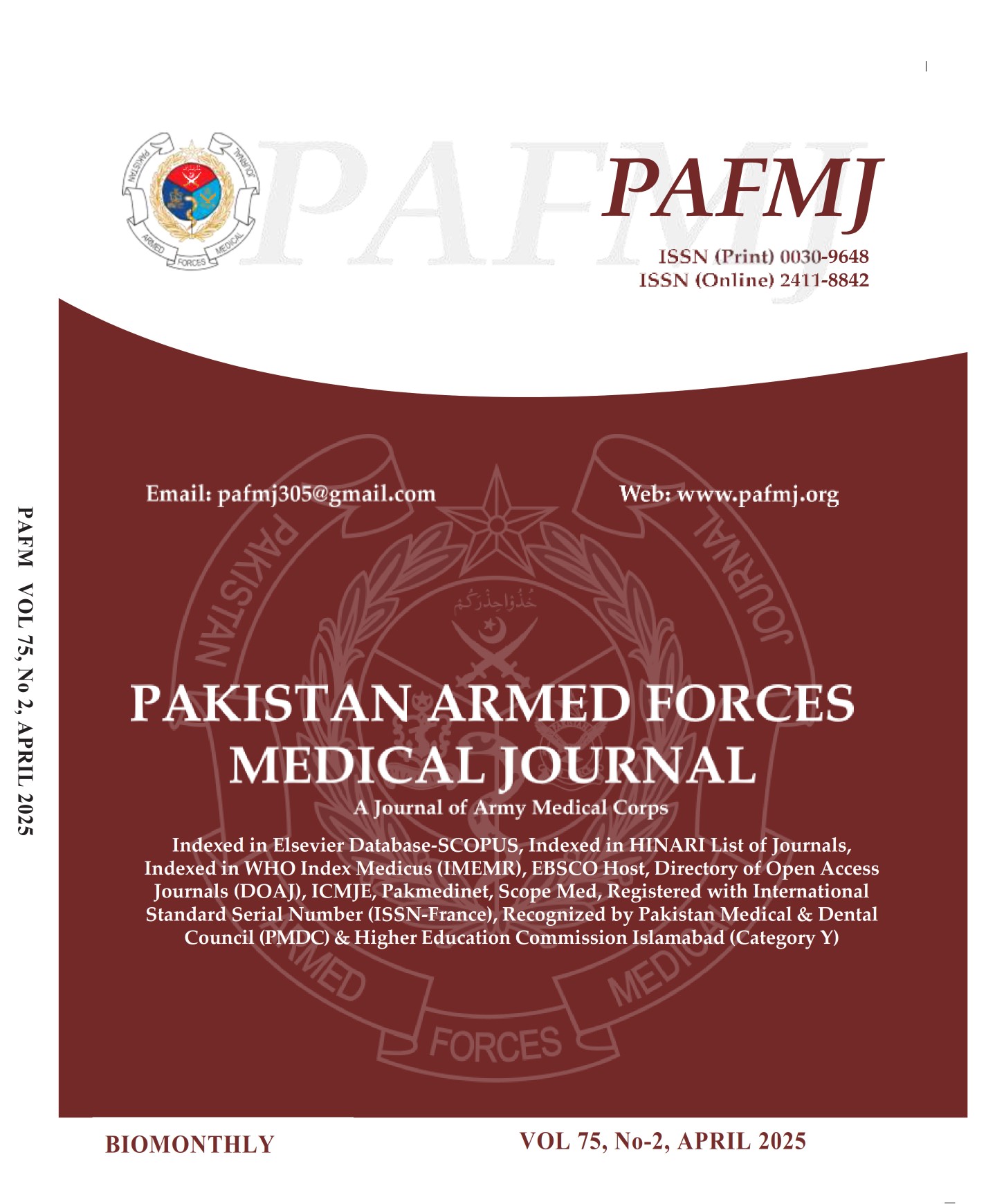The Effect of Implementing Guidelines and Changing Practices on Caesarean Section Rates in A Tertiary Care Hospital in Islamabad
DOI:
https://doi.org/10.51253/pafmj.v75i2.9182Keywords:
Caesarean Section, Delivery, Labor, Vaginal Birth after Cesarean, Neonatal Morbidity, Neonatal MortalityAbstract
Objective: To evaluate the effect of implementation of guidelines and changing practices on caesarean sections rates at Al Nafees Medical College Hospital without compromising fetal or neonatal morbidity and mortality.
Study Design: Prospective Analytical study.
Place and Duration of Study: Department of Obstetrics, Al- Nafees Medical College Islamabad, Pakistan, Jan 2012 to Jan 2017.
Methodology: All 1593 patients who underwent cesarean sections during the study period were enrolled. Data was divided into yearly periods for comparison and analysis. Sampling technique used is convenient sampling. New labor management guidelines were implemented along with regular audit and feedback in Jan 2014. Delivery statistics were compared before and after implementation of these guidelines.
Results: Rate of caesarean sections decreased from 36.4% (94 out of 258 births) in 2013 to 24.5% (125 out of 510 births) in 2016 after changing practices and implementation of guidelines. Primary cesarean section rate decreased from 54% (84 out of 155 births) in 2013 to 22% (70 out of 310 births) in 2016. Vaginal birth after cesarean section increased from 17.3% (11 out of 62 births) in 2013 to 68% (62out of 90 births) in 2016. There was no increase in fetal, or neonatal morbidity or mortality during this period.
Conclusion: Caesarean section rate was safely lowered our teaching hospital when we changed the clinical practices of the doctors and paramedical staff using supervision, audits, feedbacks and clear clinical guidelines.
Downloads
References
Husslein P. Elective caesarean section versus vaginal delivery, whether the end of traditional obstetrics. Arch Gynecol Obstet 2001 Nov; 265(4): 169-167.
https://doi.org/10.1007/s004040100221
Verma V, Vishwakarma RK, Nath DC, Khan HT, Prakash R, Abid O. Prevalence and determinants of caesarean section in South and South-East Asian women. PloS one. 2020; 15(3): e0229906. https://doi.org/10.1371/journal.pone.0229906
Haider G, Zehra N, Munir AA. Frequency and indications of cesarean section in a tertiary care hospital. Pak J Med Sci 2009; 25(5): 791-796.
Souza J, Betran A, Dumont A, De Mucio B, Gibbs. A global reference for caesarean section rates (C‐Model): A Multi-country Cross‐sectional study. Int J Obstet Gynecol 2016; 123(3): 427-436. https://doi.org/10.1111/1471-0528.13509
Sandall J, Tribe RM, Avery L. Short-term and long-term effects of caesarean section on the health of women and children. Lancet 2018; 392(10155): 1349–1357.
https://doi.org/10.1016/S0140-6736(18)31930-5
Health and Medical Care, Pregnancies, Deliveries and Newborn Infants. The Swedish Medical Birth Register 1973–2013 (Internet) Accessed December 28, 2015. Available:
https://www.socialstyrelsen.se/publikationer2014/2014-12-19
Mary Lou More. Reducing the rate of caesarean birth. J Perinat Educ 2002 11(2): 41-43.
https://doi.org/10.1624/105812402x88704
Aaron B Caughey. Safe prevention of primary caesarean delivery. Am J Obstet Gynecol 2014; 210(3): 179-193.
https://doi.org/10.1016/j.ajog.2014.01.026
Carolli G, Belizan J. Episiotomy for vaginal birth. Cochrane Database Syst Rev 2001; (2): CD000081.
https://doi.org/10.1002/14651858.cd000081
WHO statement on cesarean section rates 2015 (Internet). Accessed December 28, 2015. Available on: https://www.who.int/reproductivehealth/publications/maternal_perinatal_health/cs-statement/en/
WHO recommendations non-clinical interventions to reduce unnecessary caesarean sections. Geneva: World Health Organization; 2018. Accessed December 15, 2018. Available from: https://apps.who.int/iris/bitstream/handle/10665/275377/9789241550338-eng.pdf
Howard J. C-section deliveries nearly doubled worldwide since 2000, study finds. CNN Health 2018. Accessed December 15, 2018. Available on: https://edition.cnn.com/2018/10/11/health/c-section-rates-study-parenting-without-borders-intl/index.html.
Blomberg M. Avoiding the first cesarean section–results of structured organizational and cultural changes. Acta Obstet. Gynecol. Scand 2016 May; 95(5): 580-586.
https://doi.org/10.1111/aogs.12872
Abhishek B, Sen Gupta Dhar R, Bhartia S. Reducing caesarean section rate in an urban hospital serving women attending privately in India–a quality improvement initiative. BMC Pregnancy Childbirth 2020; 20: 1-7.
https://doi.org/10.1186/s12884-020-03234-x
Chaillet Nils C, Dumont A. Evidence‐based strategies for reducing cesarean section rates: a meta‐analysis. Birth 2007 Mar; 34(1): 53-64. https://doi.org/10.1111/j.1523-536X.2006.00146.x
Aisha A, Abeeha I, Nabeeha S, Rubeena Z, Ahmed Usman. Trends of caesarean section deliveries in Pakistan: secondary data analysis from Demographic and Health Surveys, 1990–2018. BMC Pregnancy Childbirth 2020; 20(753): 1-3.
https://doi.org/10.1186/s12884-020-03457-y
Zahumensky J, Psenkova P, Dolezal P, Otapkova P, Papcun P, Ferianec V, et al. Impact of implementing a multifaceted intervention to reduce rates of cesarean section: a quality‐improvement study. Int J Gynecol Obstet 2020; 151(2): 244-248. https://doi.org/10.1002/ijgo.13345
Khan T, Alderson S, Francis JJ, Lorencatto F, Grant-Casey J, Stanworth SJ, et al. Repeated analyses of national clinical audit reports demonstrate improvements in feedback methods. Implement Sci Commun 2020; 1(1): 1-6.
Downloads
Published
Issue
Section
License
Copyright (c) 2025 Zeba Munzar, Jaweria Faisal, Ayesha Basharat, Rakhshanda Aslam

This work is licensed under a Creative Commons Attribution-NonCommercial 4.0 International License.















